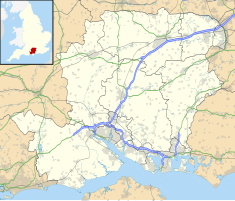
Calke Abbey is a Grade I listed country house near Ticknall, Derbyshire, England, in the care of the charitable National Trust.

Belton House is a Grade I listed country house in the parish of Belton near Grantham in Lincolnshire, England, built between 1685 and 1687 by Sir John Brownlow, 3rd Baronet. It is surrounded by formal gardens and a series of avenues leading to follies within a larger wooded park. Belton has been described as a compilation of all that is finest of Carolean architecture, said to be the only truly vernacular style of architecture that England had produced since the Tudor period. It is considered to be a complete example of a typical English country house; the claim has even been made that Belton's principal façade was the inspiration for the modern British motorway signs which give directions to stately homes.
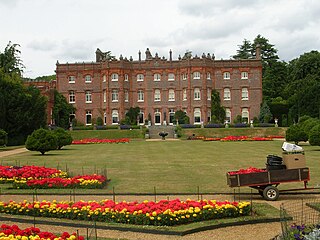
Hughenden Manor, Hughenden, Buckinghamshire, England, is a Victorian mansion, with earlier origins, that served as the country house of the Prime Minister, Benjamin Disraeli, 1st Earl of Beaconsfield. It is now owned by the National Trust and open to the public. It sits on the brow of the hill to the west of the main A4128 road that links Hughenden to High Wycombe.
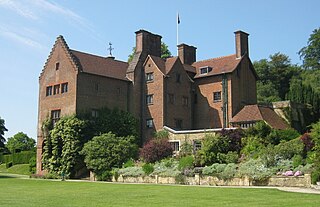
Chartwell is a country house near Westerham, Kent, in South East England. For over forty years it was the home of Sir Winston Churchill. He bought the property in September 1922 and lived there until shortly before his death in January 1965. In the 1930s, when Churchill was out of political office, Chartwell became the centre of his world. At his dining table, he gathered those who could assist his campaign against German re-armament and the British government's response of appeasement; in his study, he composed speeches and wrote books; in his garden, he built walls, constructed lakes and painted. During the Second World War, Chartwell was largely unused, the Churchills returning after he lost the 1945 election. In 1953, when again prime minister, the house became Churchill's refuge when he suffered a debilitating stroke. In October 1964, he left for the last time, dying at his London home, 28 Hyde Park Gate, on 24 January 1965.

Canons Ashby House is a Grade I listed Elizabethan manor house located in the village of Canons Ashby, about 11 miles (17.7 km) south of the town of Daventry in the county of Northamptonshire, England. It has been owned by the National Trust since 1981 when the house was close to collapse and the gardens had turned into a meadow. "The Tower" of the building is in the care of the Landmark Trust and available for holiday lets.

Tichborne is a village and civil parish 4 miles (6.4 km) east of Winchester in Hampshire, England.

Bishop's Sutton or Bishop's Sutton is a village and civil parish one mile (1.6 km) east of the market town of Alresford in the City of Winchester district of Hampshire, England. According to the 2001 census it had a population of 419, increasing to 463 at the 2011 Census.

Lord Sherborne, Baron of Sherborne, in the County of Gloucester, was a title in the Peerage of Great Britain. It was created in 1784 for James Dutton, who had earlier represented Gloucestershire in Parliament. He was the son of James Dutton by Anne Dutton, daughter of Sir Ralph Dutton, 1st Baronet. His father had assumed the surname of Dutton in lieu of his patronymic on succeeding to the Dutton estates in 1743. The title became extinct upon the death of the eighth Baron in 1985.

Dyrham Park is a baroque English country house in an ancient deer park near the village of Dyrham in South Gloucestershire, England. The house, with the attached orangery and stable block, is a Grade I listed building, while the park is Grade II* listed on the National Register of Historic Parks and Gardens.
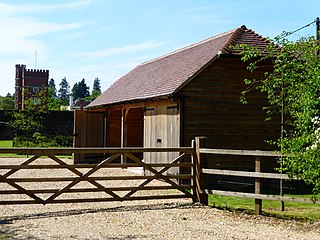
Brockwood Park is a country estate located in the civil parish of Bramdean and Hinton Ampner, in the Winchester district, in the county of Hampshire, England. Historically, it was situated in the now reformed parish of Bramdean. There is a Krishnamurti school on the grounds of the estate known as Brockwood Park School, and The Krishnamurti Centre, a retreat centre.

Norbury Park is an area of mixed wooded and agricultural land surrounding a privately owned its Georgian manor house near Leatherhead and Dorking, Surrey. On the west bank of the River Mole, it is close to the village of Mickleham.

Bramdean is a village and former civil parish, now in the parish of Bramdean and Hinton Ampner, in the Winchester district, in the county of Hampshire, England. It is a linear settlement located along the busy A272 trunk road which was widened by the American troops in 1943 in preparation for D-Day.

Adrian John Tinniswood FSA is an English writer and historian. He is currently Professor of English Social History at the University of Buckingham.

Lytes Cary is a manor house with associated chapel and gardens near Charlton Mackrell and Somerton in Somerset, England. The property, owned by the National Trust, has parts dating to the 14th century, with other sections dating to the 15th, 16th, 18th, and 20th centuries. "Yet all parts blend to perfection with one another and with the gentle sunny landscape that surrounds them," comments Nikolaus Pevsner. The House is listed as Grade I by English Heritage.

Norbury Manor is a 17th-century manor house with an adjoining 14th-century stone-built medieval hall house, Norbury Hall, known as The Old Manor, in Norbury near Ashbourne, Derbyshire. It is a Grade I listed building.
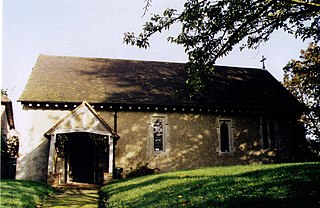
West Worldham is a small village and former civil parish, now in the parish of Worldham, in the East Hampshire district of Hampshire, England. It is 2.1 miles (3.4 km) southeast of the town of Alton. The village of East Worldham is to the East and Hartley Mauditt is to the South, which along with West Worldham form the current Parish of Worldham.

Ralph Stawell Dutton, 8th Baron Sherborne (1898–1985), was the 8th and last Baron Sherborne. He created the gardens at Hinton Ampner near Alresford in Hampshire, England, and on his death left the house and garden to the National Trust. It is now open to the public.
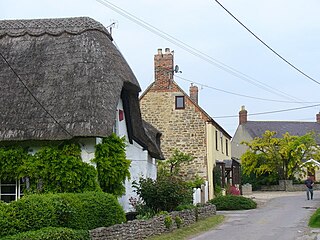
Hinton Parva, also known as Little Hinton, is a village in the Borough of Swindon in Wiltshire, England. It lies about 2 miles (3.2 km) from the eastern edge of the Swindon built-up area, and is separated from the town by farmland and the village of Wanborough. The village has a Grade I listed church which has Norman origins. Hinton Parva was a separate civil parish until 1934, and is now in the parish of Bishopstone.

